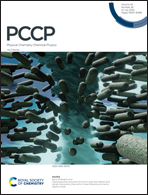Perturbation theory of scattering for grazing-incidence fast-atom diffraction
Abstract
Recent grazing-incidence, fast atom diffraction (GIFAD) experiments have highlighted the well known observation that the distance between classical rainbow angles depends on the incident energy. The GIFAD experiments imply an incident vertical scattering angle, facilitating an analytic analysis using classical perturbation theory, which leads to the conclusion that the so called “dynamic corrugation” amplitude, as defined by Bocan et al., Phys. Rev. Lett., 2020 125, 096101 is, within first-order perturbation theory, proportional to the tangent of the rainbow angle. Therefore it provides no further information about the interaction than is gleaned from the rainbow angle and its energy dependence. Perhaps more importantly, the resulting analytic theory reveals how the energy dependence of rainbow angles may be inverted into information on the force field governing the interaction of the incident projectile with the surface.

- This article is part of the themed collection: New Trends and Challenges in Surface Phenomena, Carbon Nanostructures and Helium Droplets


 Please wait while we load your content...
Please wait while we load your content...